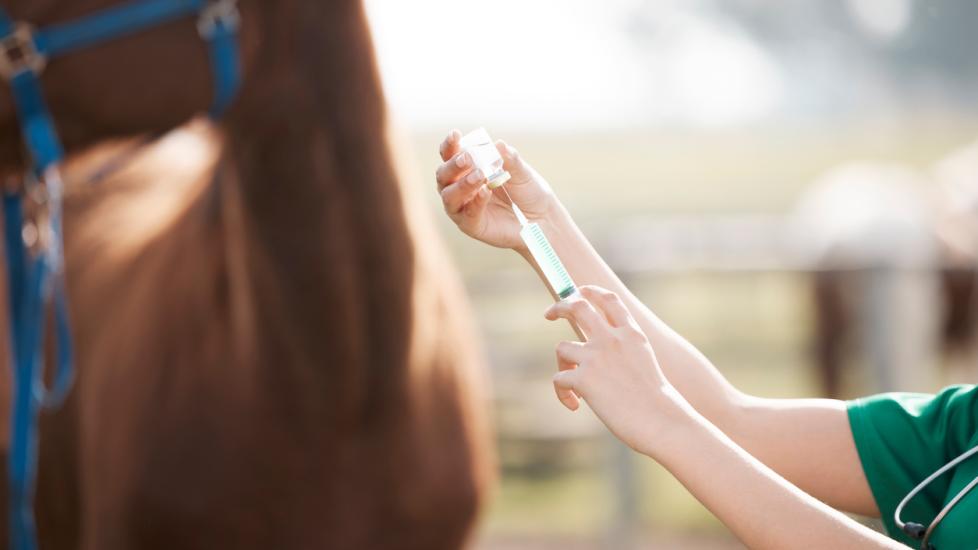Tetanus in Horses
What is Tetanus in Horses?
Tetanus is a neurological disease that horses are prone to acquiring. While it is a preventable disease, it is still common in the United States. It is caused by a toxin produced by the bacterium Clostridium tetanii. This toxin blocks the signal that tells muscles to function, which over time will lead to complete paralysis. The responsible bacteria can be found worldwide, and any horse can become infected.
Symptoms of Tetanus in Horses
The first symptom of tetanus in horses is knowing if they acquired a wound recently–usually within the last month. The incubation period after a wound can be as little as three days. As clinical signs begin to show, you may notice some of these potential indicators:
-
Stiffness or “sawhorse” stance
-
Mild colic
-
Abnormal gait
-
Prolapsed third eyelid
-
Raised tail
-
Muscle spasms
-
Lockjaw, or inability to open mouth to chew food
-
Extreme hypersensitivity to sound and light, which causes overreactions of fright
-
Decreased manure and urine output
-
Inability to rise
-
Respiratory difficulty
-
Death
Once signs start to show, the disease progresses quite rapidly, leading to death sometimes within a few days if the symptoms are severe or treatment is delayed.
Causes of Tetanus in Horses
Tetanus is caused by the bacteria Clostridium tetanii. This bacterium lives primarily in the soil, or in manure; it is contracted by horses through the skin when they have a wound. Unfortunately, horses are one of the most susceptible species to this disease, and the bacteria can enter the body through a break in the skin as small as a paper cut. These bacterial spores enter the body, then reproduce if the conditions are favorable. When these spores begin to die, they release a neurotoxin that is released into the horse’s nervous system which leads to all the above clinical symptoms.
How Veterinarians Diagnose Tetanus in Horses
Tetanus is diagnosed based on the assumption history of a wound, and the clinical signs. This becomes very suspect especially if a horse is unvaccinated or has an unknown vaccine history. A blood test can also definitively identify the toxin; however, because this typically takes several days to receive results, treatment is instituted in the meantime.
Treatment of Tetanus in Horses
If a horse is unvaccinated for tetanus, the mortality (death) rate for horses is approximately 80%. If symptoms are caught early and your veterinarian suspects tetanus, they may attempt the following treatment plan:
-
Antibiotic (Penicillin) injection twice daily
-
Tetanus antitoxin therapy
-
Hospitalization in a dark, quiet, deeply bedded stall
-
Muscle relaxants
-
Sedatives if needed to help keep your horse calm and quiet
-
If your horse has acquired aspiration pneumonia, colic, or other secondary conditions, your horse may also require intravenous (IV) fluids, other antibiotics or anti-inflammatories, etc.
Recovery and Management of Tetanus in Horses
If symptoms are noted early and treatment is started right away, recovery is possible for horses with tetanus. However, death or euthanasia is the result in many tetanus cases, especially in unvaccinated horses. As the horse’s muscle’s “lock up,” several secondary conditions can occur, including:
-
Colic due to difficulty of eating/drinking and decreased mobility of the gastrointestinal tract
-
Aspiration pneumonia if food is not swallowed appropriately and ends up in the lungs
-
Dehydration
If your horse lays down and is unable to rise, the prognosis becomes grave for recovery. It’s important to call your veterinarian right away if you notice any of the potential signs of tetanus in your horse, so treatment can be started as soon as possible and potentially save your horse’s life.
Prevention of Tetanus in Horses
Luckily, tetanus is easy to prevent in horses using annual vaccines administered by your veterinarian. The tetanus vaccine series is started in foals at 4-6 months of age with a repeat booster, then yearly administration at the time of their general physical and wellness exam. If your horse gets a cut, and it’s been more than six months since their last vaccine, your veterinarian may recommend administering their booster early to ensure your horse is adequately protected, since this vaccine does not create extended or lifelong protection.
Tetanus in Horses FAQs
What are the warning signs of tetanus?
The very first indication of your horse possibly getting tetanus is getting a wound or cut. If you see any break in the skin and your horse has not had a tetanus vaccine administered by your veterinarian in the previous six months, call your vet to examine the wound and to update your horse’s tetanus vaccine.
How long does it take for tetanus to set in horses?
After a wound occurs, tetanus symptoms typically begin within a few weeks, but can be as little as just a couple of days.
Is tetanus curable in horses?
If the signs are caught early and aggressive treatment is started by your veterinarian right away, horses can survive tetanus. It is crucial to have your horse examined as soon as possible if you believe your horse may be displaying signs of tetanus.
Featured Image: iStock.com/PeopleImages
